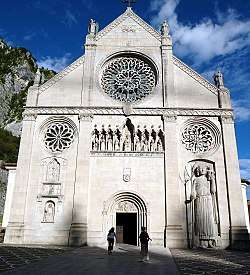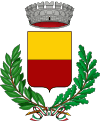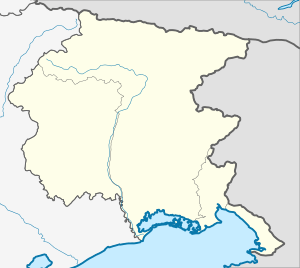Gemona del Friuli
Gemona del Friuli (Friulian: Glemone, Slovene: Humin, German: Klemaun) is a comune (municipality) in the Province of Udine in the Italian region Friuli-Venezia Giulia, located about 90 kilometres (56 mi) northwest of Trieste and about 25 kilometres (16 mi) northwest of Udine.
Gemona del Friuli | |
|---|---|
| Città di Gemona del Friuli | |
 Cathedral of Gemona. | |
 Coat of arms | |
Location of Gemona del Friuli 
| |
 Gemona del Friuli Location of Gemona del Friuli in Italy  Gemona del Friuli Gemona del Friuli (Friuli-Venezia Giulia) | |
| Coordinates: 46°17′N 13°8′E | |
| Country | Italy |
| Region | Friuli-Venezia Giulia |
| Province | Udine (UD) |
| Frazioni | Campagnola, Campolessi, Maniaglia, Ospedaletto, Godo, Centro Storico, Stalis, Taviele, Taboga |
| Government | |
| • Mayor | Roberto Revelant |
| Area | |
| • Total | 56.2 km2 (21.7 sq mi) |
| Elevation | 272 m (892 ft) |
| Population (30 November 2008)[2] | |
| • Total | 11,175 |
| • Density | 200/km2 (520/sq mi) |
| Demonym(s) | Gemonesi |
| Time zone | UTC+1 (CET) |
| • Summer (DST) | UTC+2 (CEST) |
| Postal code | 33013 |
| Dialing code | 0432 |
| Patron saint | Santa Maria Assunta |
| Saint day | December 8 |
| Website | Official website |
The municipality of Gemona del Friuli contains the frazioni (subdivisions, mainly villages and hamlets) Campagnola, Campolessi, Maniaglia, Ospedaletto, Godo, Centro Storico, Stalis, Taviele and Taboga.
Gemona del Friuli borders the following municipalities: Artegna, Bordano, Buja, Lusevera, Montenars, Osoppo, Trasaghis and Venzone.
History
Evidence of human occupation in Gemona goes back to prehistoric times. The town occupies a key point on the road from Italy to Austria, and there are traces of Celtic occupation around the year 500 BC.
The area was subject to various invasions in the period 166–750, including Huns, Marcomanni, Ostrogoths, Visigoths and Lombards, who had it as a stronghold from about 558. Lombard historian Paul the Deacon mentions it in 611 as an "impregnable castle". From the fall of the Lombard Kingdom of Italy until 952 Gemona was under Carolingian rulers. During this period the castle was built, the modern town growing around it.
From 776, Gemona became an important part of the Patriarchate of Aquileia. In the 12th century Gemona was an autonomous commune: in 1184 the Emperor Frederick Barbarossa granted a charter for the town's market. In the 13th and 14th centuries it returned to the Patriarchate, until, in 1420, that state was absorbed by the Republic of Venice.
In 1797 French troops under Napoleon defeated the Venetian Republic: in 1798, after the Treaty of Campoformio, Gemona came under Austrian rule. Following a plebiscite in 1866, Gemona became part of the newly unified Kingdom of Italy.
The present town is medieval in origin but was badly damaged in the 1976 Friuli earthquake. Restoration began the same year, and now the town has been largely restored. The castle is currently under reconstruction.
Main sights
Gemona's main attraction is the medieval cathedral (Duomo), dating to the 14th century, with its massive campanile (freestanding bell tower) of the same period.
 Hulk of the “Chiesa della Beata Vergine delle Grazie”, as a result of the 1976 earthquake.
Hulk of the “Chiesa della Beata Vergine delle Grazie”, as a result of the 1976 earthquake.
Transport
Twin towns



References
- "Superficie di Comuni Province e Regioni italiane al 9 ottobre 2011". Istat. Retrieved 16 March 2019.
- All demographics and other statistics: Italian statistical institute Istat.
